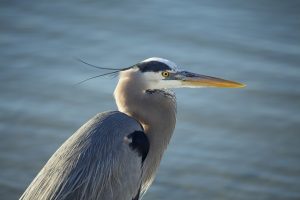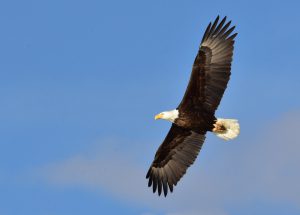Texas officially has 18 documented species of hawk, not including similar birds of prey like kites, falcons, and eagles.
For Falcon species in Texas, see our Texas Falcons and How to Tell Them Apart.
Of the 18 hawk species, several are rare for the state, while others are seasonal and only in Texas during certain months. Below is the list of all hawks species documented in Texas.
Texas Hawk Species
- Red-tailed Hawk
- Red-shouldered Hawk
- Cooper’s Hawk
- Sharp-shinned Hawk
- Swainson’s Hawk
- Northern Harrier
- Broad-winged Hawk
- White-tailed Hawk
- Harris’s Hawk
- Gray Hawk
- Ferruginous Hawk
- Rough-legged Hawk
- Zone-tailed Hawk
- Common Black-Hawk
- Short-tailed Hawk
- Roadside Hawk
- Crane Hawk
- Great Black Hawk
Quick Comparison for Common Hawks
Did you recently see a hawk? There’s a 90% chance it’s one of the following three:
| Species | Size | Appearance |
| Red-tailed Hawk | Large | Adults have red tails, “belly band” across midsection. |
| Red-shouldered Hawk | Medium-large | Reddish-brown, orange barring down breast & belly. |
| Cooper’s Hawk | Small-medium | Dark top of head, orange barring down breast. |
If you saw a group of hawks on the ground in a field, they were Swainson’s Hawks.
The Easiest Way to Identify a Hawk you Saw
- Look at the range
- Look at the seasonal timing
To check range and seasonal timings, use a field guide like The Sibley Guide to Birds (Amazon), or a free app like Audubon Bird Guide (Audubon).
Even if you think you know what type of hawk you saw, if it’s outside its normal range, that’s probably not it. You probably won’t see a White-tailed Hawk in Dallas, or a Zone-tailed Hawk in Houston. It’s just not where they live.
If a hawk is outside its seasonal timing (Summer/Winter/ Spring or Fall migration), then instead look at hawks in the current season. Northern Harriers are only present during winter. Swainson’s Hawk are only present mid-Spring through mid-Fall. Use this to your advantage.
Always assume the more common species. This rule will significantly improve your accuracy.
Red-tailed Hawk
Identifying Characteristics:
- Red color in tail feathers (adults only)
- The “belly band” – a line of dark spots across the midsection
- Light shoulder spots on the back
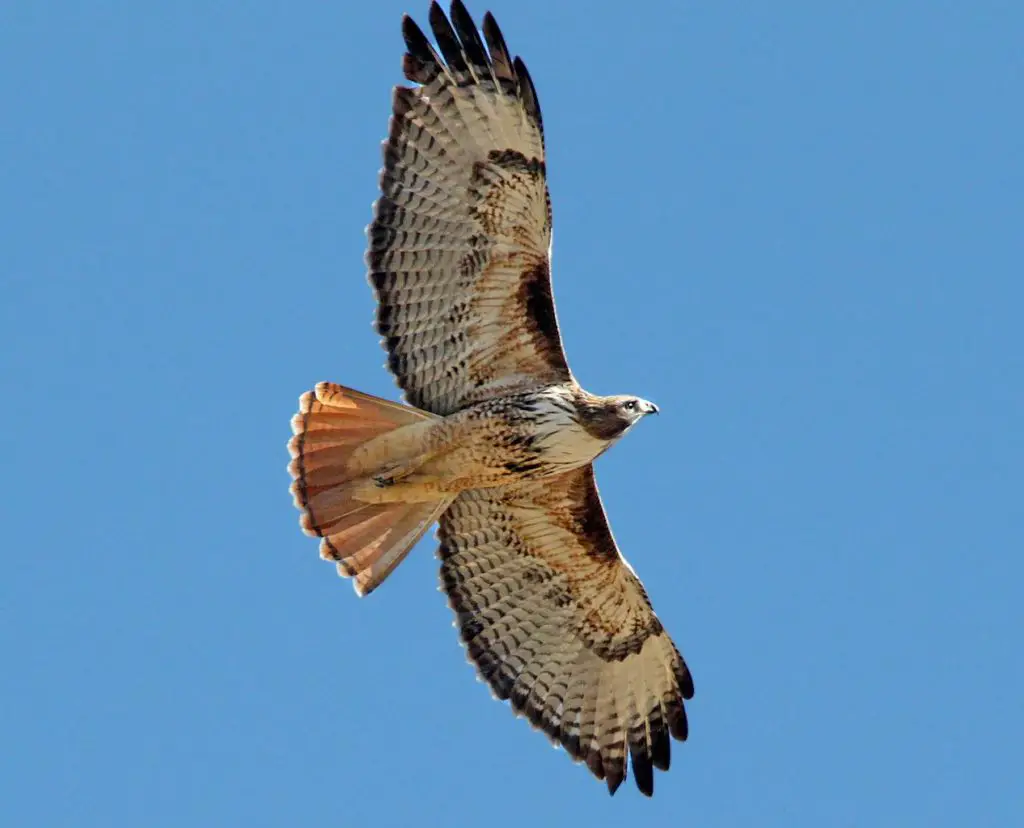
This is the most commonly seen hawk species in Texas.
Often found perched on telephone poles and large trees, their large size makes them conspicuous as they sit out in the open.
Not all Red-tailed Hawks actually have red color in the tail feathers, only the adults do. Juvenile hawks have just white and brown in the tail.
The belly band is the most important feature of this species.
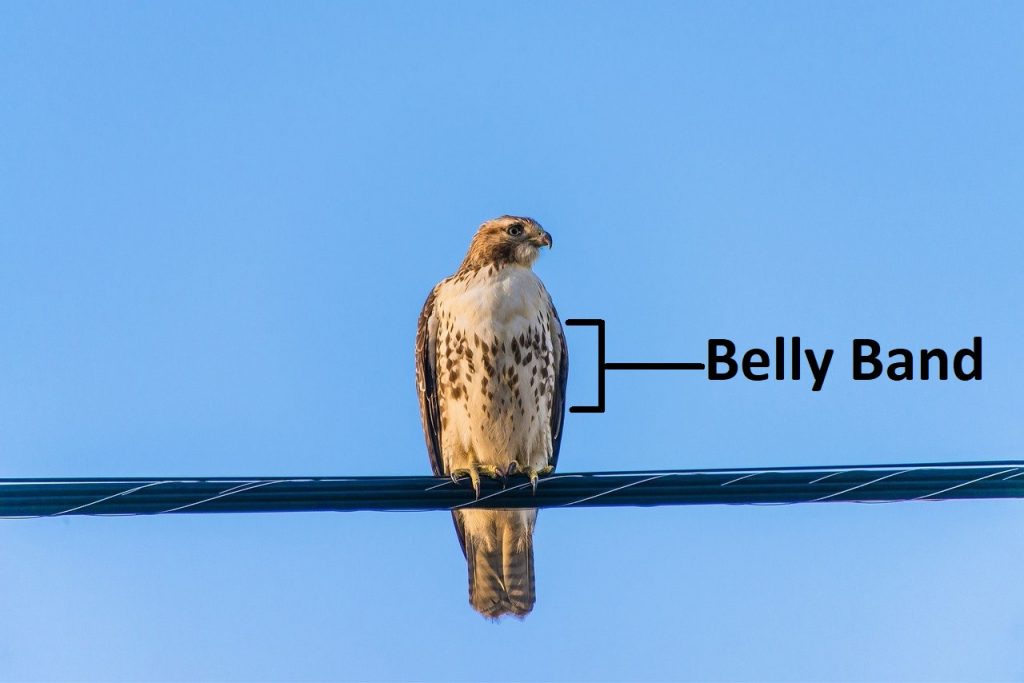
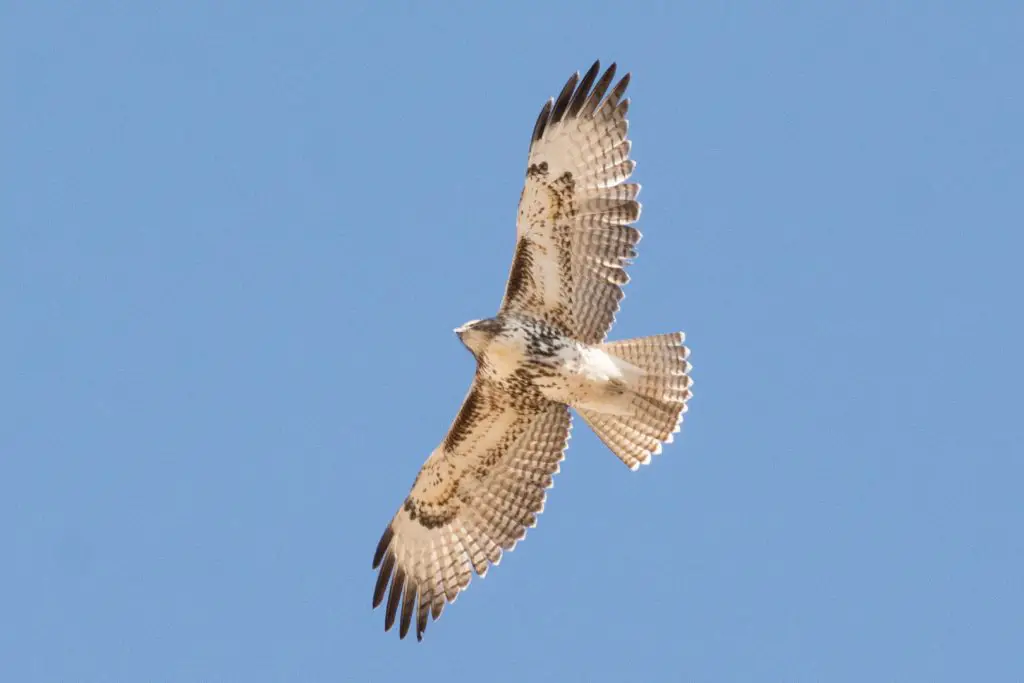
This large hawk prefers open areas like grassy fields and agricultural fields. They can be found all over the state during all four seasons.
Red-shouldered Hawk
Identifying Characteristics:
- Orange color on front and shoulders
- Appearance of black and white spotting on back and wings
- Black and white bars across the tail

Red-shouldered Hawks love woodlands, especially in riparian areas with creeks, ponds, or rivers. They’re most often seen perched in a large tree, or flying low from one wooded spot to another.

Their repetitive “Creee…creee…creee!” call is easily recognizable, but be careful – Blue Jays frequently do near-perfect imitation calls of these hawks.
Cooper’s Hawk/Sharp-shinned Hawk
Identifying Characteristics:
- Smaller and more slender than other hawks
- Thin orange bars across breast and belly
- Light gray and dark gray bars across outside of tail feathers

These two hawks are closely related and are both in the genus accipiter. Telling them apart requires skill and experience, and is beyond the depth of this article.
Accipiters specialize in preying on other birds. Common targets include doves, pigeons, sparrows, starlings, and sometimes even woodpeckers.
They’re most often confused with Red-shouldered Hawks because of the orange barring on the front. Know that Red-shouldered Hawks are chunkier, or bigger around. Accipiters have a more slim build, made for speed rather than power.
Adult Cooper’s and Sharp-shinned Hawks also have dark caps on top of their head, while Red-shouldered Hawks have a medium to light color on top of their head.
Swainson’s Hawk
Identifying Characteristics:
- Reddish brown breast, like a bib
- White throat, just under the beak
- Light colored belly
- Solid dark brown back
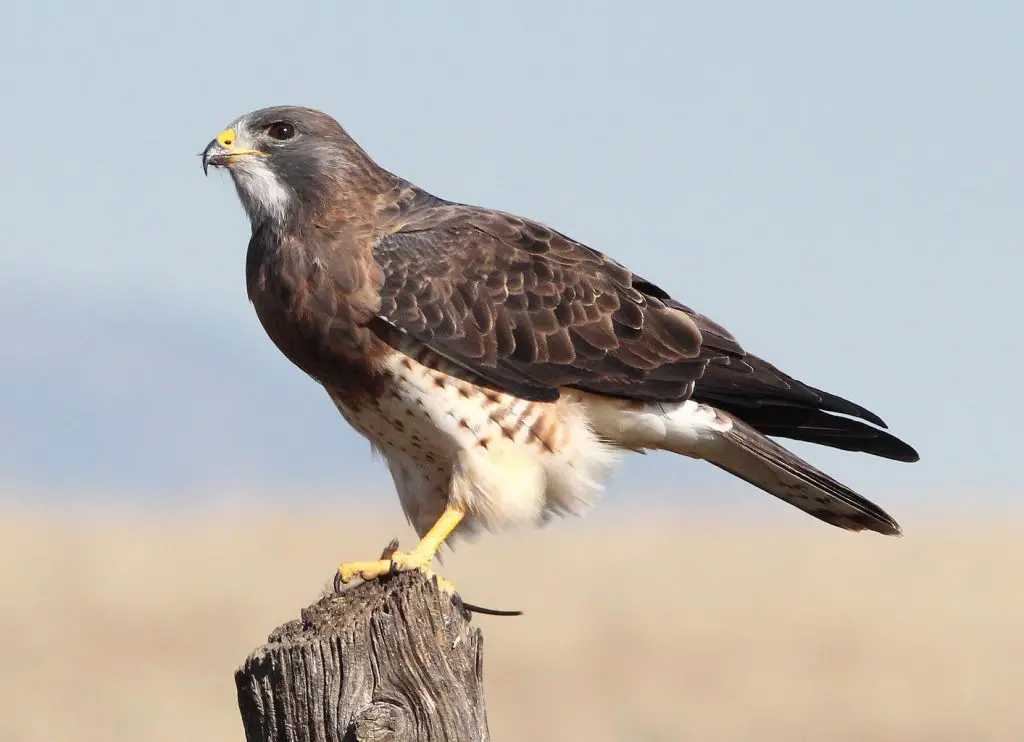
Swainson’s Hawks are similar to Red-tailed Hawks in their large size and prefered habitat.
They are a summer hawk in Texas, present from mid-April to late October. Telephone poles and large dead trees are favorite perching spots.
Swainson’s Hawk are sometimes seen in large groups (10-100) sitting on the ground in open dirt fields, especially during migration months like April and September/October. They’re looking for grasshoppers and other easy snacks before they continue migrating.
If you see a large hawk with a white throat just under the beak, a red-brown breast, and off-white belly, then it’s a Swainson’s.
Northern Harrier
Identifying Characteristics:
- White “rump” (top of the tail)
- Gliding low over a field
- Disc shaped face resembles an owl

Northern Harriers are grassland predators, common around the outskirts of towns and in rural areas. They love wide open spaces like fields and agricultural areas.
This is a winter species in Texas. The first migrants typically appear in September, with numbers surging in November. The last spring migrants head north in April.
Unlike other hawks, Northern Harriers primarily hunt by sound. Hearing rodents in the grass is easier if they’re close, which is why Harriers are almost always seen flying very low to the ground.
Females are more common than males, and can be identified by their brown color. Males are gray, and nicknamed “Gray Ghosts” because of how they silently glide back and forth through the air.

If you see a hawk low to the ground in an open field, and it has a bright white spot on the top of the tail, it’s a Northern Harrier.
Broad-winged Hawk
Identifying Characteristics:
- Single large white band across the tail
- Migratory, seen during April-May and September-October.

Broad-winged Hawks can look similar to Red-shouldered Hawks, but with less color on the breast. The breast can be heavily barred, splotchy and spotted, or with no obvious markings at all.
These are woodland hawks, hunting in areas with dense, tall hardwood trees. However in Texas, they’re almost always seen flying overhead as they migrate north in the spring or south in the fall.
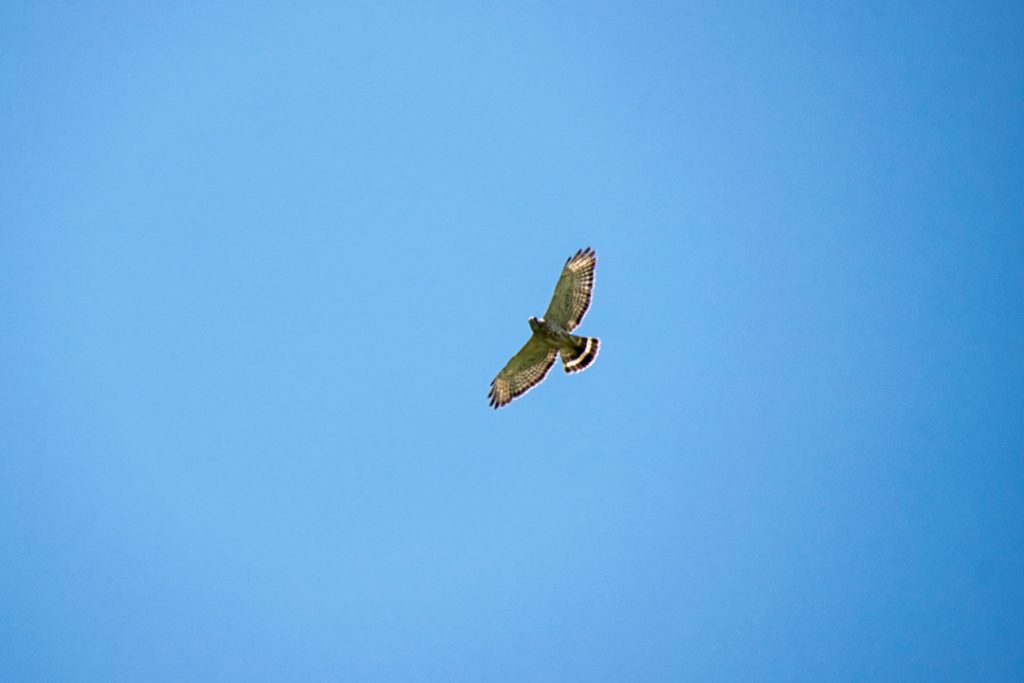
Broad-winged Hawks migrate in groups, sometimes with only several individuals, but sometimes hundreds or even thousands strong.
If you see a big group of hawks flying overhead in April or September, Broad-winged Hawk is a likely candidate (the other is Swainson’s Hawk, which has longer and more pointed wings in flight).
White-tailed Hawk
Identifying Characteristics:
- Solid white tail with dark band across the tip
- Dark gray-brown on the back
- Red-brown shoulder feathers (marginal coverts)
- Found in the southern third of the state

Good Locations to See Them:
- Attwater Prairie Chicken National Wildlife Refuge
- Aransas National Wildlife Refuge
- Kingsville Area
- Santa Ana National Wildlife Refuge
- Bentsen Rio Grande Valley State Park
- Laguna Atascosa National Wildlife Refuge
White-tailed Hawks are typically found within 100 miles of the coast. You can think of their range being south of Interstate 10 between Houston and San Antonio, and southeast of Interstate 35 between San Antonio and Laredo.
These larger hawks are grassland hunters, seen near coastal prairies and agriculture fields. Hunting on the wing is typical, then abruptly dropping on prey from above at the first sight of movement.
Their bright white tail with a single black band at the tip gives them away even from a distance, although their light gray back and top of wings is also a helpful clue.
Harris’s Hawk
Identifying Characteristics:
- Overall red-brown color
- White undertail feathers
- Usually seen no more than 25 feet above the ground
- Only found south of San Antonio
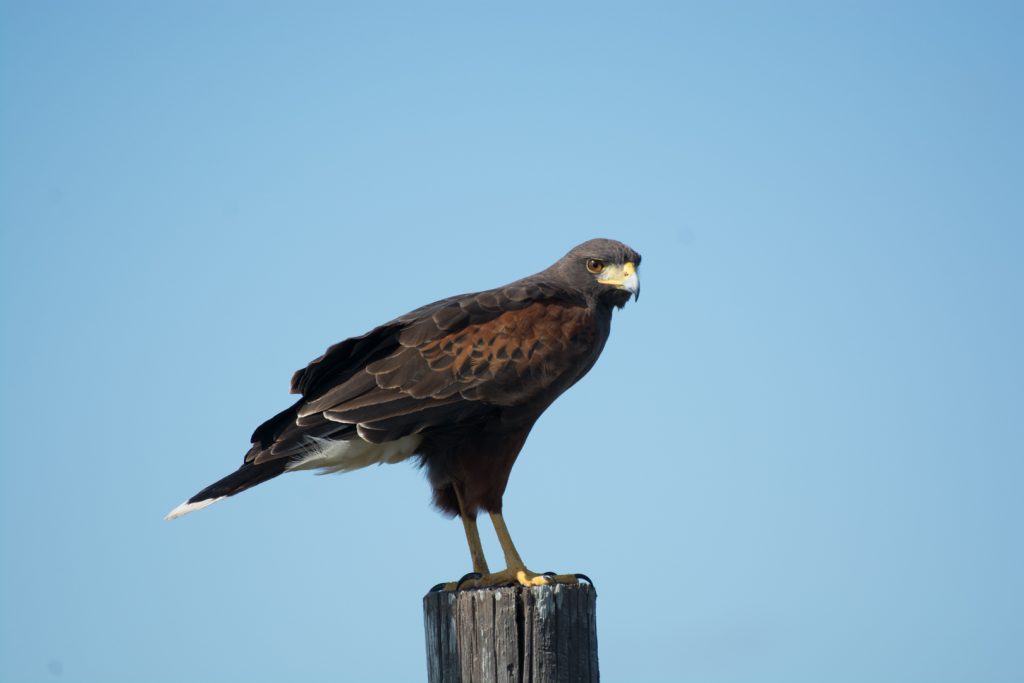
Harris’s Hawks are a classic south Texas species, and seeing them north of San Antonio is highly unusual. But there’s plenty of areas south of San Antonio where they seem to be the most common hawk around.
They’re preferred habitat is dense, large Mesquite trees for perching with nearby open spaces for hunting.
Rich red color in the wings on their brown body is the most visible and helpful clue in identifying this species. The white patch of feathers under the tail confirms the ID.
Gray Hawk
Identifying Characteristics:
- Only in far South Texas near the border
- Gray all over
- Black and white stripes in the tail
- Usually seen near water

If you don’t live within 45 minutes of the U.S.-Mexico border then you can skip this tropical species.
Along the Rio Grande, these hawks stick to densely wooded areas near water. Their favorite food item is lizards, which they catch with their quick and agile flight style.
Adults are easy to identify due to their overall gray color, but be aware the juveniles look very different.
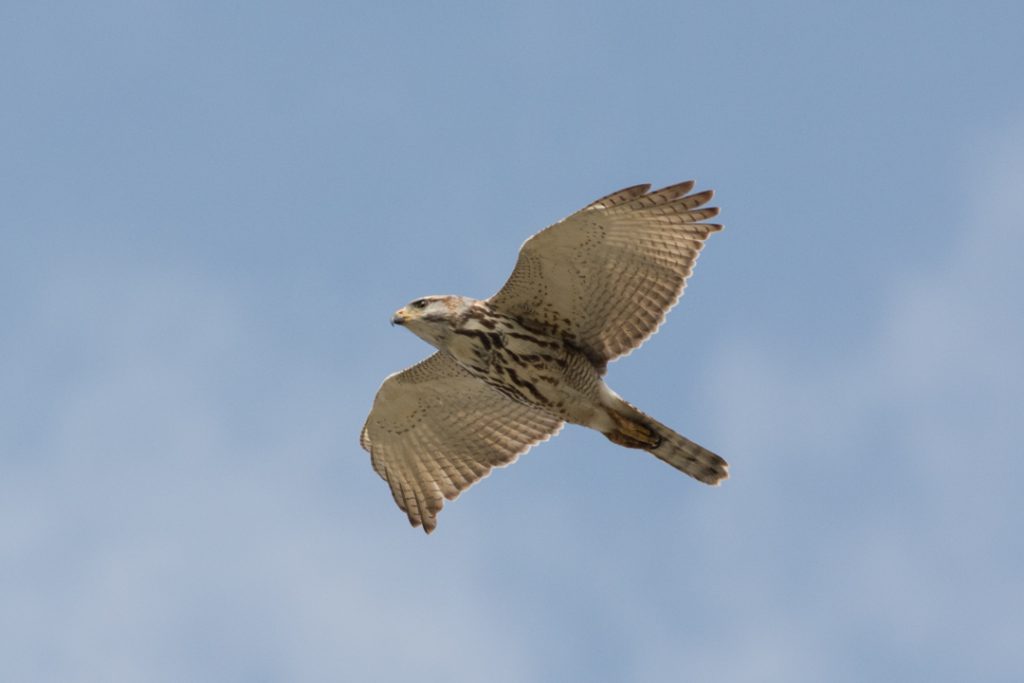
Ferruginous Hawk
Identifying Characteristics:
- Only present in Texas during winter
- White breast
- Reddish wings
- Present in the western half of the state

This is the largest hawk species in Texas, and it’s found in the panhandle and far west Texas during winter months.
Perched on electrical poles and wooden posts is where they’re most commonly seen.
Birders can separate them from the more common Red-tailed Hawk by the overall lighter body color and rufous color (red/brown) in the wings.
Their preferred hunting grounds are massive swaths of open grassland and prairie, making the panhandle the perfect region to see these large raptors.
Rough-legged Hawk
Identifying Characteristics:
- Only present in Texas during winter
- Typically only seen in the panhandle
- Dark wrist patches on wings (underside)
- White patch near tips of wings (underside)

Rough-legged Hawks are typically only seen in Texas in the panhandle, from Lubbock and up. They usually lack major physical characteristics that give them away, making identifying them tricky.
The most helpful tip for identifying them is the dark wrist patch, although it’s only visible in flight.
Zone-tailed Hawk
Identifying Characteristics:
- All dark body and wings
- White band in the tail
- Present in south and west Texas
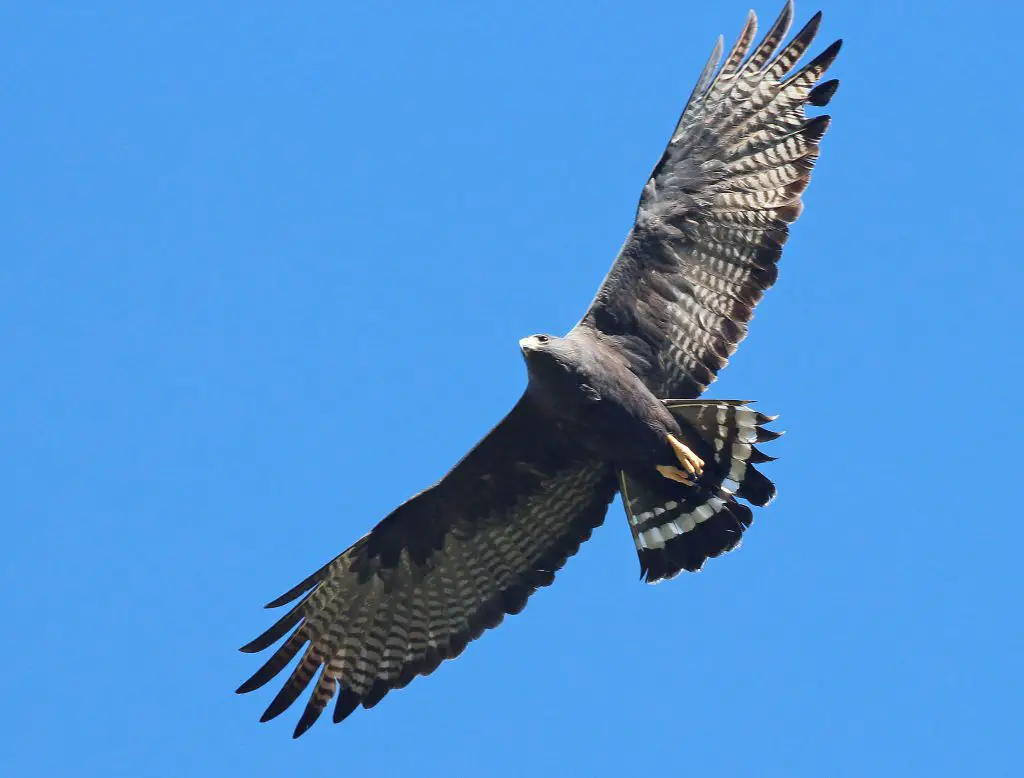
Zone-tailed Hawks are uncommon in all areas, but usually restricted to the southern and western regions of the state. Occasionally they’re seen in the central Texas Hill Country, north and west of Austin and San Antonio.
Except for unusual dark morphs of other species, the only other hawk that looks really similar is the Common Black Hawk, which are very unusual and highly range restricted in Texas. Zone-tailed Hawks are much more common and widespread.
This hawk looks extremely similar to the common Turkey Vulture, and is sometimes overlooked because of this.
Common Black Hawk
Identifying Characteristics:
- Usually only seen far west Texas
- Dark body and wings
- White band in the tail

Common Black Hawks are a rare sighting in Texas, except in Big Bend National Park and near the Davis Mountains. They’re a desert species found near flowing, wooded streams and rivers.
Similar to the more common Zone-tailed Hawk, the main difference is the very broad, wide wings seen in flight. Zone-tailed Hawks have more narrow, straight wings.
The easiest place to see this species is Rio Grande Village in Big Bend National Park, where a pair nest in the same group of trees each year. Nesting season is mid-March through early August.
Short-tailed Hawk
Identifying Characteristics:
Clean white breast and stomach
Underwing secondaries darker than primaries

Fewer than 75 individuals have ever been reported in Texas, with nearly all reports in west Texas mountains, far south Texas along the Mexican border, and a few west of San Antonio in the Hill Country.
This isn’t a hawk most Texans will ever run into, and even if you do, it’s tricky to ID. There’s no obvious markings or colors that give it away, but the clean white body is a clue.
Roadside Hawk
Identifying Characteristics:
- Very rare, only seen along Mexican border
- Small, just larger than a Cooper’s Hawk
- Brownish color in wings and breast
- Gray head and back

This species has fewer than 15 individuals ever reported in Texas, with every one of them being right on the Texas-Mexico border in south Texas.
When they do show up, they tend to stay in one spot for several weeks. This makes it easier for birders around the state to travel and see this rare species when it does appear once every few years.
Crane Hawk
Identifying Characteristics:
- (Only one confirmed sighting in Texas)
- Overall black to charcoal gray
- Long tail with two white bands
- Red legs

A single Crane Hawk was seen in 1987 in Santa Ana National Wildlife Refuge, located in far south Texas. It stuck around until April 1988, until it left the area probably to find a mate.
It can be separated from other Texas hawks by its overall dark gray color and intensely red legs.
This species hasn’t been seen since that first state record, but it will probably make another Texas appearance sometime in the coming years (or decades?)
Great Black Hawk
Identifying Characteristics:
- (Only one confirmed sighting in Texas)
- Larger hawk with broad, wide wings
- Black Tip of Beak
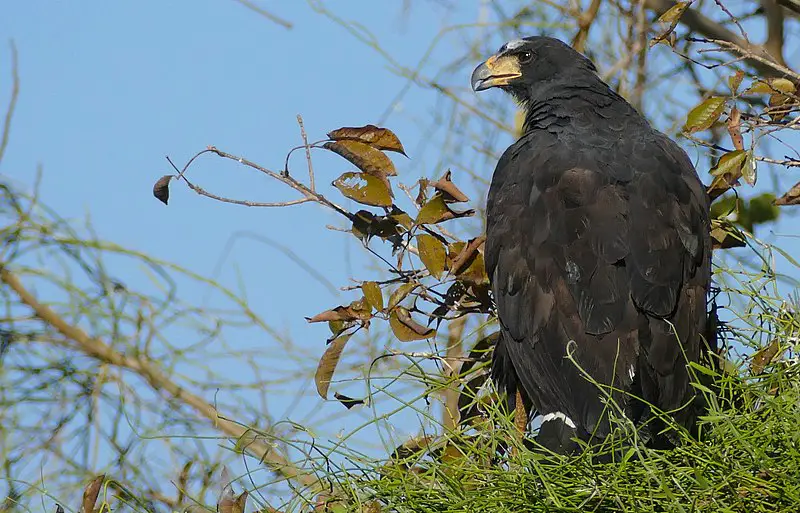
This is another tropical hawks species that has only been seen once in the state of Texas.
In April 2018, a juvenile was photographed on South Padre Island as it was being harassed and chased by grackles. Only 3 people saw it before it flew off.
Many birders visited the island in the following days, hoping to refind this incredibly rare Texas species, but none succeeded.
Great Black Hawks are very similar to Common Black Hawks in appearance, but slightly larger in overall size. Beak color is a good way to separate them. Common Black Hawks will have lighter color beaks, either blueish or yellowish. Great Black Hawks have black beaks with no visible color.


